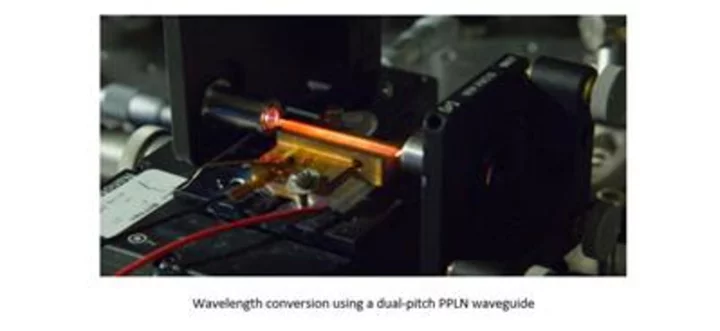TOKYO--(BUSINESS WIRE)--Aug 15, 2023--
NTT Corporation (NTT) and Tokyo Denki University have succeeded in further stabilizing the graduated frequency of an optical frequency ruler generated by modulating the intensity and phase of laser light in an electrical signal. By using this result, it is possible to obtain a light source with a narrow linewidth whose frequency interval is 25 GHz, and it is expected to be applied to high-speed and large-capacity optical communications such as next-generation digital coherent transmission. In addition, microwaves with significantly reduced phase noise can be generated, which is expected to improve the accuracy of microwave generation and evaluation equipment. This research was published in the British scientific journal, Scientific Reports on May 30, 2023, and was presented in an invited talk at PIERS2023, an international conference on photonics, electromagnetics and information communications, on July 3, 2023.
This press release features multimedia. View the full release here: https://www.businesswire.com/news/home/20230815636886/en/
Wavelength conversion using a dual-pitch PPLN waveguide (Photo: Business Wire)
Results:
NTT and their partners have developed a detection and control mechanism for the CEO signal ( fceo ), which has been difficult for electro-optic modulation-based optical frequency comb.
Research Background:
An optical frequency comb (OFC) [1] is an optical signal that has a comb-like emission line spectrum on the frequency axis and is used for optical frequency measurement and precise frequency conversion from light to microwave. If the frequency interval of the OFC is defined as frep, and the frequency closest to 0 (Carrier-envelope offset frequency, hereinafter CEO frequency) when the frequency interval of the OFC is virtually swept to 0, the frequency is defined as fceo, the frequency f n of the OFC can be written as f n = fceo + n × frep using the natural number n.
Frequency-stabilized OFCs have been realized using fiber combs [2] and Ti:sapphire lasers [3]. However, the typical frequency intervals ( frep ) of these OFCs are tens to hundreds of MHz, which makes them difficult to use in optical communication applications [4] because each comb mode cannot be individually separated and controlled. To address this problem, the research group has studied the OFC (EO comb) [5] that generates sidebands by feeding a CW laser [6] into an electro-optic modulator (EO modulator) [7]. Because the frequency interval of EO combs is up to several tens of GHz, the comb modes can be individually separated and controlled, making them suitable for optical communication applications. In addition, by selecting the microwave frequency to be applied to the EO modulator, the frequency interval can be easily changed, expanding the range of applications. On the other hand, as the EO comb moves away from the seed light source on the frequency axis, microwave noise is superimposed and the frequency becomes unstable, so the frequency must be stabilized.
NTT and Tokyo Denki University have been researching technology to stabilize the frequency of EO comb [8]. Although the previous method used two lasers with different frequencies, there was room for improvement in the stability of the EO comb due to frequency drift [9] between the lasers.
Key Points of Technology:
(1) Generation of EO comb with high signal-to-noise ratio by multi-stage EO modulation.
Because EO combs have a low energy per pulse, they typically use long, highly nonlinear fibers to generate broadband OFC. On the other hand, this method reduces the signal-to-noise ratio of the OFC and makes it difficult to detect the CEO frequency (see Technical Detail 1 for detection methods). This time, NTT used seven phase modulators [10] to broaden the sidebands, and then used short, highly nonlinear fibers to generate EO combs with high bandwidth and high signal-to-noise ratio.
(2) Use of the 2 f -3 f self-referencing interferometer, in which the CEO frequency can be detected by an OFC in the 2/3-octave bandwidth.
In a conventional f -2 f self-referencing interferometer, the OFC is broadened from the frequency f to 2 f to generate a second harmonic light at the frequency of f and to receive the interference signal at a frequency close to 2 f. In this 2 f -3 f self-referencing interferometer, the OFC is broadened from the frequency f to 3 f /2, to generate a third harmonic light at the frequency of f and a second harmonic light at the frequency of 3 f /2, to receive the interference signal at a frequency close to 3 f. This reduces the OFC bandwidth required to detect the CEO frequency. The research group used NTT's proprietary 2 f -3 f self-referencing interferometer with a dual-pitch PPLN waveguides.
Research Results:
The research group succeeded in further stabilizing the EO comb by using a single laser as the seed light source, detecting the CEO frequency ( fceo ), which had been difficult in the EO comb and feeding it back to the microwave frequency applied to the EO modulator to keep fceo constant.
[Experiment Method]
The fluctuation of the CEO frequency was estimated with a frequency counter [11]. An experimental result shows that the fluctuation of the CEO frequency was inversely proportional to the measurement time. This is direct evidence that the CEO frequency has been stabilized in EO comb.
The stability of the EO comb was also evaluated by measuring the phase noise [13] of the stabilized microwave. An experimental result shows that the phase noise of microwave (frequency: frep = 25 GHz) was reduced to below the measurement limit of the highly accurate phase noise analyzer [14]. In particular, compared to when the news was released in 2016, the noise level has reduced by less than a tenth. Based on these results, the microwave stability was estimated to be comparable to that of commercial high-precision hydrogen masers [15].
Furthermore, the linewidth of the EO comb was evaluated by taking the interference signal between the narrow-linewidth laser and the frequency-stabilized EO comb at a wavelength of 1397 nm. An experimental result shows that the linewidth of the 811th EO comb counted from the seed light source (frequency: f s ) was 300 Hz, which is about 3 orders of magnitude smaller than the laser linewidth required for digital coherent communication. This result is considered to provide a light source for optical communication that can support even higher communication speed.
Future Development:
In this study, we demonstrated that even EO combs with a large frequency interval can stabilize the CEO frequency. In addition, EO comb linewidth is sufficiently narrower than the laser linewidth required for digital coherent communications. As communication speeds increase further, more precise control of the laser linewidth is required. In this study, it was possible to provide multiple light sources for optical communication in a single experimental system, and it is expected to enable high-speed, large-capacity optical communications using EO comb.
Furthermore, NTT succeeded in reducing the phase noise of microwaves to below the measurement limit of a highly accurate phase noise analyzer. This is expected to improve the accuracy of microwave generation and evaluation equipment and be used for timekeeping [16] in places where GPS signals are difficult to reach. In the future, NTT aims to further improve the frequency stability and convenience of the EO comb. We will also develop technologies that provide high-precision microwave signals, reduce errors in position measurements and time stamps and realize technologies that contribute to areas that require real-time, accurate data (e.g., traffic control, air traffic control, financial transactions, etc.).
Technical Details:
1. Detection method of CEO frequency:
If you take the second harmonic generation (SHG) of the n -th frequency f n of the OFC, the frequency becomes 2 f n. By taking the interference signal between this and the 2 n-th frequency f2 n of the OFC, its frequency becomes 2 f n - f2 n = fceo, and the CEO frequency is detected. Therefore, this method requires the OFC to be spread over a wide bandwidth from f n to f2 n.
2. 2 f -3 f self-referencing interferometer with dual-pitch PPLN waveguides:
Dual-pitch PPLN waveguides are periodically poled lithium niobate (PPLN) waveguides with two pitch sizes, which convert wavelengths by utilizing the nonlinearity of lithium niobate (LiNbO 3 ). The first stage of the dual-pitch PPLN waveguide generates a second-harmonic light with a wavelength of 1800 nm to 900 nm, and the second stage generates a sum-frequency light with a wavelength of 1800 nm and a wavelength of 900 nm to produce a third harmonic light with a wavelength of 600 nm. The second stage of the waveguide simultaneously generates a second-harmonic light with a wavelength of 1200 nm to 600 nm. Therefore, it is possible to detect the CEO signal by 2 f -3 f self-referencing interferometer simply by injecting a 2/3-octave bandwidth of EO comb into the waveguide.
3. Applications of optical frequency measurement:
As a stabilized EO comb application, NTT focused on absolute optical frequency measurement technology and determined the optical frequency f s of the seed light source. The optical frequency can usually be measured with a precision of eight to nine digits using a high-precision wavelength meter [17]. When a high-precision wavelength meter and an OFC are used together, the optical frequency can be measured with an accuracy of 11 to 12 digits. Wavelength meters, on the other hand, require a light source of known frequency for calibration. We have shown that this method can determine the optical frequency with the accuracy of 12 digits without using a reference light source of known frequency. The optical frequency f s of the seed light source can be written as f s = fceo + s × frep using the comb mode number s ( s: natural number). To determine the unknown constants f s and s, we examined the relationship between fceo and frep under two different conditions. Note that if a fiber laser with a small frequency interval frep is used, the number of significant digits required to determine the value of s increases, and it is difficult to obtain the comb mode number s by this method. By using an EO comb with a large frequency interval, we avoided this problem and demonstrated that the optical frequency f s can be measured with an accuracy of 12 digits without using a light source with a known frequency.
Research Sponsor:
This research was conducted in collaboration with Tokyo Denki University and was partially supported by a Grant-in-Aid for Scientific Research "Creation of Ultra-High Precision Frequency Conversion Technology Using an Electro-Optic Modulator-Based Optical Frequency Comb (Research Representative: Atsushi Ishizawa)" (No. 17H02803) from the Ministry of Education, Culture, Sports, Science and Technology-Japan.
Information on publication of papers and presentations at international conferences:
Publication Magazine: Scientific Reports
Research Title: “Optical-Referenceless Optical Frequency Counter With Twelve-Digit Absolute Accuracy”
Author: Atsushi Ishizawa, Tadashi Nishikawa, Kenichi Hitachi, Tomoya Akatsuka & Katsuya Oguri
International Conference: PIERS 2023
Announcement Title: Low-Phase-Noise Frequency-Tunable Microwave and Millimeter-Wave Generation Using an Electro-Optic-Modulation Comb”
[Glossary]
- Optical Frequency Comb (OFC):
On the frequency axis, it is an optical signal with a comb spectrum, but on the time axis, it is a pulsed laser with a repetition frequency of frep. In the pulse, the electric field oscillates rapidly. The phase shift for each pulse is the carrier-envelope offset phase, which is linearly related to the CEO frequency. Frequency ( fceo and frep ) stabilized OFC is a revolutionary optical technology whose achievement earned the 2005 Nobel Prize in Physics. - Fiber Comb:
An OFC whose resonators are all optical fibers. - Ti:Sapphire Laser:
An OFC that uses an artificially created Ti:sapphire crystal as the laser medium inside the resonator. - Optical Communication Applications:
Intended for use as a light source for high-density, wavelength-multiplexed optical transmission. EO comb can match the frequency interval recommended by the International Telecommunication Union, such as 25 GHz. - EO Comb:
An OFC generated using an EO modulator. When a CW laser is fed into an EO modulator, the electro-optic effect of the EO modulator allows intensity and phase modulation to be applied to the CW laser. These modulations produce sidebands centered on the CW laser and generate an OFC. - CW Laser:
A type of laser in which the laser power is a constant value without changing with time. This type of laser has a single frequency. - Electro-Optical Modulator (EO Modulator):
An optical device used to modulate the intensity or phase of light by electricity (microwaves). - 2016 Press Release:
Frequency stabilization of frep is achieved by using two lasers of different frequencies (seed and reference sources) and feeding it back to the microwave so that the frequency difference ( fbeat ) between the microwave-induced noise superimposed comb mode and the reference source remains constant. For more information, please visit below.
https://www.brl.ntt.co.jp/J/2016/05/latest_topics_201605171837.html - Frequency Drift:
A gradual shift or change in frequency over a period of time. - Phase Modulator:
An EO modulator that modulates the phase of light by microwaves. The intensity modulator is an EO modulator that modulates the intensity of light by microwaves. - Frequency Counter:
An instrument that measures the center frequency of microwaves. - Allan Deviation:
Fluctuation of the center frequency normalized to the light frequency. - Phase Noise:
A measure of the purity of microwaves. The signal is expressed in terms of frequency components at a certain distance from the center frequency (offset frequency). The lower the value, the less noise the signal has. - Phase Noise Analyzer:
An instrument that measures the phase noise of microwaves. - High-precision Hydrogen Maser:
A maser using atomic beams of neutral hydrogen atoms. The narrow linewidth of the spectrum provides a frequency stability of about 10 -13, and is used as a frequency standard. - Timekeeping:
To keep the time accurately without GPS signal. - Wavelength Meter:
An instrument that measures the wavelength (or frequency) of light.
About NTT
NTT contributes to a sustainable society through the power of innovation. We are a leading global technology company providing services to consumers and business as a mobile operator, infrastructure, networks, applications, and consulting provider. Our offerings include digital business consulting, managed application services, workplace and cloud solutions, data center and edge computing, all supported by our deep global industry expertise. We are over $100B in revenue and 330,000 employees, with $3.6B in annual R&D investments. Our operations span across 80+ countries and regions, allowing us to serve clients in over 190 of them. We serve over 75% of Fortune Global 100 companies, thousands of other enterprise and government clients and millions of consumers.
About Tokyo Denki University
Tokyo Denki University (TDU) was founded in 1907 by two young engineers who played active roles in the industrial world, Seiichi Hirota and Shinkichi Ogimoto, to concretize their sublime idea, “Promoting engineering education is indeed the foundation for the development of a nation.” Through its solid and diligent academic culture, TDU has been fostering students for more than a century with the mission, “Development of Human Resources Who Contribute to Society by Technology.” TDU also has been providing quality instruction based on the two educational maxims: “Respect for Practical Study” and “Students First.” TDU continues to cultivate excellent human resources to meet the needs of society, changing with the times to make significant contributions to the development of Japan’s science and technology. For more information on TDU, visit https://www.dendai.ac.jp/en/.
View source version on businesswire.com:https://www.businesswire.com/news/home/20230815636886/en/
CONTACT: NTT
Public Relations
nttrd-pr@ml.ntt.comTokyo Denki University
Planning and Public Relations Department, General Affairs Department
keiei@jim.dendai.ac.jpNick Gibiser
Account Manager
Wireside Communications
For NTT
ngibiser@wireside.com
KEYWORD: UNITED STATES JAPAN NORTH AMERICA ASIA PACIFIC
INDUSTRY KEYWORD: SCIENCE OTHER ENERGY OTHER SCIENCE UTILITIES RESEARCH ENERGY TECHNOLOGY OTHER TECHNOLOGY
SOURCE: NTT
Copyright Business Wire 2023.
PUB: 08/15/2023 09:57 AM/DISC: 08/15/2023 09:57 AM
http://www.businesswire.com/news/home/20230815636886/en









